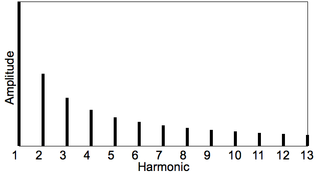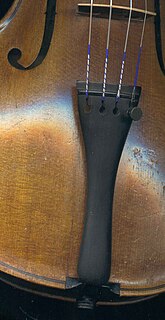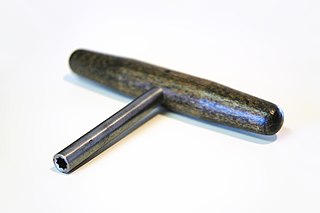Tuner may refer to someone or something which adjusts or configures a mechanical, electronic, or musical device.

In music, inharmonicity is the degree to which the frequencies of overtones depart from whole multiples of the fundamental frequency.

A key is a specific part of a musical instrument. The purpose and function of the part in question depend on the instrument.

A tailpiece is a component on many stringed musical instruments that anchors one end of the strings, usually opposite the end with the tuning mechanism.

The zhongruan, is a Chinese plucked string instrument. The zhongruan has a straight neck with 24 frets on the fingerboard and 4 strings. It is usually played with a plectrum. It can also be played with fingers, which is similar to the way of playing the pipa (琵琶). The zhongruan is a tenor-ranged instrument in the family of ruan (阮). In ancient China, the ruan was called Qin pipa or Ruan xian (阮咸). Now the ruan has expanded to different sizes and the zhongruan is the "medium" one.

A nut, on a stringed musical instrument, is a small piece of hard material that supports the strings at the end closest to the headstock or scroll. The nut marks one end of the vibrating length of each open string, sets the spacing of the strings across the neck, and usually holds the strings at the proper height from the fingerboard. Along with the bridge, the nut defines the vibrating lengths of the open strings.

Making an instrument of the violin family may be done in different ways, many of which have changed very little in nearly 500 years since the first violins were made. Some violins, called "bench-made" instruments, are made by a single individual, either a master maker, or an amateur working alone. Several people may participate in the making of a "shop-made" instrument, working under the supervision of a master. Various levels of "trade violin" exist, often mass-produced by workers who each focus on a small part of the overall job, with or without the aid of machinery.

A violin consists of a body or corpus, a neck, a finger board, a bridge, a soundpost, four strings, and various fittings. The fittings are the tuning pegs, tailpiece and tailgut, endpin, possibly one or more fine tuners on the tailpiece, and usually a chinrest, either attached directly over the tailpiece or to the left of it.

Playing the violin entails holding the instrument under the chin, supported by the left shoulder. The strings are sounded either by drawing the bow across them (arco), or by plucking them (pizzicato). The left hand regulates the sounding length of the strings by stopping them against the fingerboard with the fingers, producing different notes.

A tuning wrench is a specialized socket wrench used to tune string instruments such as the piano, harp, and hammer dulcimer, that have strings wrapped around tuning pins. Other string instruments do not require a tuning wrench because their tuning pins or pegs come with handles, or geared tuning machines.

A scroll is the decoratively carved beginning of the neck of certain stringed instruments, mainly members of the violin family. The scroll is typically carved in the shape of a volute according to a canonical pattern, although some violins are adorned with carved heads, human and animal. The quality of a scroll is one of the things used to judge the luthier's skill. Instrument scrolls usually approximate a logarithmic spiral. Although many references assert that the instrument scroll closely follows the golden spiral this assertion is demonstrably false. Scrollwork is a common feature of Baroque ornament, the period when string instrument design became essentially fixed.

The Paraguayan harp is the national instrument of Paraguay, and similar instruments are used elsewhere in South America, particularly Venezuela.

The saw duang is a two-stringed instrument used in traditional Thai music. The sound is produced by the bow made from horsetail hair which goes between the strings made from silk. The bow has to be tilted to switch from one string to another. Saw duang is light and played vertically on the lap. It creates a bright tone unlike the Saw u which produces a mellow sound. Another instrument which is similar to the Saw duang is the Chinese stringed instrument called Huqin.

A bridge is a device that supports the strings on a stringed musical instrument and transmits the vibration of those strings to another structural component of the instrument—typically a soundboard, such as the top of a guitar or violin—which transfers the sound to the surrounding air. Depending on the instrument, the bridge may be made of carved wood, metal or other materials. The bridge supports the strings and holds them over the body of the instrument under tension.

The Guitarrón Chileno is a guitar-shaped plucked string instrument from Chile, with 25 or 24 (rarely) strings. Its primary contemporary use is as the instrumental accompaniment for the traditional Chilean genre of singing poetry known as Canto a lo Poeta, though a few virtuosi have also begun to develop the instrument's solo possibilities.

A tromba marina, or marine trumpet is a triangular bowed string instrument used in medieval and Renaissance Europe that was highly popular in the 15th century in England and survived into the 18th century. The tromba marina consists of a body and neck in the shape of a truncated cone resting on a triangular base. It is usually four to seven feet long, and is a monochord. It is played without stopping the string, but playing natural harmonics by lightly touching the string with the thumb at nodal points. Its name comes from its trumpet like sound due to the unusual construction of the bridge, and the resemblance of its contour to the marine speaking-trumpet of the Middle Ages.

The Viola da terra is a stringed musical instrument from the Portuguese islands of the Azores. It may have either 12 strings arranged in 5 courses, or 15 strings, arranged in either 5 or 6 courses. The strings are made of metal.






























